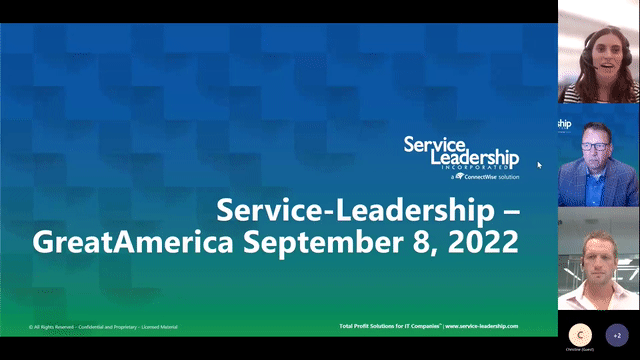

By: GreatAmerica on September 26th, 2022
Service Providers, How to Best Manage New & Current Clients
Lee Rozeboom, Vice President and Managing Director of Sales at Great America, and Peter Kujawa, Vice President of Service Leadership, a ConnectWise solution hosted a webinar recently discussing how to overcome pressures in the current MSP world by implementing some best practices.
To view the full webinar, please visit here:

Dive into this blog to learn more about best practices for managing clients in the Solution Provider world.
Best practices for solution providers
The pressures in the Solution Provider landscape are overwhelming and seem to never stop growing. Currently Solution Providers are fighting with The Great Resignation, equipment delays, commoditization of IT, inflation, among so much more. In this blog, we’ll review the current state of the industry, and how solution providers can manage all these pressures while creating a positive environment for customers.
Here are the best practices we will cover:
- Benchmarking
- Price Increase Management
- Offer Financing
- Account Management
State of the industry
As of right now, the state of the industry is overall positive. The best-in-class solution providers, which can be defined as the top 25% of performers based on adjusted EBITDA, continue to grow within the industry. The average adjusted EBITDA for best-in-class last quarter was 24.5%, and these solution providers continue to have the fastest revenue growth. There is only about 20% churn in the top quartile, and when the best-in-class do fall, they don’t fall for long.
The average EBITDA for the bottom quartile, was -11.4% last quarter. There is a lot of churn in the bottom quartile; there seems to be a trend of either getting better, going out of business, or selling as a distressed asset.
There has also been a lot of chatter about whether we are in a recession. And if we are, what does the future look like? Peter addressed this point, saying if there is a recession in the macro economy, there is not one yet in the managed service landscape. In fact, the approximate company valuation has gone up, and revenue has continued to increase over the past eight quarters.
Though the expectation was to see gross margin percentage go down from wage inflation, it instead improved slightly. Peter shared Service Leadership research that found two factors: the first is that the best-in-class solution providers are doing a great job of increasing their pricing. The second factor uncovered was that many open positions remain unfilled. So even though the cost of hiring technical talent has gone up, the positions left unfilled have been favorable from a cost perspective. As Peter alluded, he recognizes that this is not sustainable and over time there will still be an impact on gross margin percentage if companies are not sufficiently raising prices. But for now, through quarter two of 2022, the industry is still doing well.
The benefits of benchmarking
Benchmarking is an amazing tool to improve your business. It’s a great way to compare your data to the best in the industry or what was defined earlier as ‘best-in-class’. Benchmarking gives an awareness of how your business is doing and what areas you can improve in. Benchmarking helps standardize your business, set expectations, and help your business to be a best-in-class organization.
Price increase management importance
To fight inflation and boost service gross margin, you need to implement a best-in-class price increase management methodology. Best-in-class is currently between 4-5%. For this methodology you should follow a handful of rules:
- Multi-year contracts should include escalators
- Use 3.9% or 4.1% instead of 4%, and use 4.9% and 5.1% instead of 5%
- Don’t use ‘up to X%’ (the client will read this as an opportunity to negotiate annually)
- If you don’t have escalators in your current contracts, fix it today
- Approach current clients today, don’t wait until renewal
- Revisit new contract pricing every six months
- Use financing to offset impact to clients
Standardize and offer financing to customers
What and when your customers buy matters. The longer customers hang onto equipment, the noisier those customers become, and out-of-date equipment is a silent killer. Outdated equipment is a huge drain on gross margin percentage because response times are longer per incident, you have more responses per client, and your team is just not as familiar with the wide range of products that need support if you aren’t promoting new technology.
Fully standardizing your team helps to efficiently support the products. You can hire and train less skilled employees and they can get up to speed faster which in result lowers labor costs.
How your customers buy technology matters too. A cash sale has a noisier environment, security risks, and is often timelier. In addition, ownership takes place on day one which creates a community of technology hoarders by encouraging prolonged use, which prevents customers from embracing and optimized technology refresh schedule.
To avoid the headaches that come along with cash sales, offer technology financing/HaaS to your customers. HaaS helps avoid budgetary objections, and instead allows customers to acquire technology via a smaller, monthly payment. Usage-based programs like HaaS help to mitigate technology hoarding since customers don’t own the equipment on day one. With HaaS, your customers are using tomorrow’s inflated dollars for today’s purchase and if you do it well, it will show results.
Prioritizing customers with account management
Account management is critical, and Peter recommends analyzing your clients on a quarterly basis using ABCD analysis, which rates them on an ABCD scale that follows these criteria:
- “D” clients are outlier clients and they are under 30% gross margin. The action recommended for D clients is to raise prices significantly (2-3x) or recommend competitors to your client.
- “C” clients are similar to D clients, but they are at least over 30% gross margin. Discovery is needed for C clients to move them to either the B or D category and then take corresponding action.
- “B” clients are your clients that are near full pricing but not there yet. For B clients you want to develop a plan to achieve a higher market share of these clients and have them consume your full range of offerings.
- “A” clients are your best clients. For A clients you want to stay close, provide support to maintain your relationship, and do quarterly business reviews.
To be successful when using ABCD analysis, Peter recommends you complete the analysis at least quarterly. You should also establish a threshold to exclude the smallest clients, or simply put, decide whether they fall into an ‘expand’ or ‘ignore’ category. This means focusing on D clients first because they have the highest impact on your organization. They are negatively impacting your business by being your least profitable. Furthermore, this group usually includes your most difficult clients, so by finding a place for them you are practicing addition by subtraction. Lastly, as you upsell your D and C clients, make sure you are offering HaaS and financing.
How to implement these best practices
GreatAmerica can help support you as you implement these best practices. Take these two steps to get started: Fill out the OML tool and reach out to the GreatAmerica Team. We will work with you to select 3 - 5 of your d customers, build out a monthly plan for this group, and support you as you move those customers up or out.
To learn more about benchmarking with Service Leadership Index®, please visit here.
If you missed part one of this two-part webinar series, ‘Navigating Economic Uncertainty’ with Peter and Lee, be sure to sign up for part two, taking place on October 27 at 1 p.m. CT. In this session, they will discuss best practices for recruiting and retention. Solution Providers should focus on improving their profitability and operational effectiveness while times are good to put them in a better position to make other adjustments and withstand any downturn.
GreatAmerica
GreatAmerica Financial Services® is the largest family-owned national commercial equipment finance company in the United States. With $3.5+ billion in assets and life-to-date finance originations of $16.1 billion, GreatAmerica is dedicated to helping manufacturers, distributors, resellers, and franchisees be more successful and keep their customers for a lifetime. GreatAmerica offers innovative, complementary services in addition to financing. Established in Cedar Rapids, Iowa in 1992, GreatAmerica also maintains offices in Des Moines, IA, Marshall, MN, Milton, GA, and Northbrook, IL. The company is deeply rooted in the communities where it has offices, contributing more than $1.1 million annually through its Donor Advised and Employee Advised Funds—empowering team members to guide charitable giving and make a meaningful difference where they live and work.
